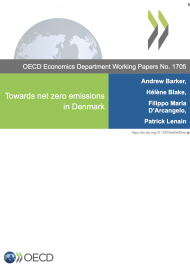
Denmark has been a frontrunner in policies that reduce greenhouse gas emissions and now plans to cut emissions by 70% by 2030 from 1990 levels and to achieve carbon neutrality by 2050. Such ambition induces halving emissions from 2019 levels and making the same emission abatement effort in ten years than the past thirty years. Cutting emissions at such fast pace will be challenging with substantial disruptions and macroeconomic consequences. A balanced mix of pricing policies, public investment, regulation and enabling policies should allow smoothing the potential economic and social shocks and accompanying the reallocation of resources.
This paper investigates further sectoral climate strategies in Denmark. In the energy sector (electricity and district heating), past progress made to ramp up clean technologies provides a good blueprint to achieve further decarbonisation, but the focus will need to be put soon on lowering reliance on woody biomass. In the transport sector, emissions have continued to increase despite the shift to more fuel-efficient vehicles, highlighting the need for more transformative policies to expand alternatives to individual car uses. In agriculture, little has been done so far to cut emissions, especially from livestock. The sector is subject to leakage risks, but nonetheless should be encouraged to transform its practices. Helping farmers to monitor their GHG emissions should be combined with more stringent regulation.




